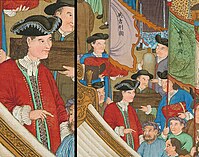Ten Thousand Nations Coming to Pay Tribute
Qing dynasty painting From Wikipedia, the free encyclopedia
Ten Thousand Nations Coming to Pay Tribute (Chinese: 萬國來朝圖; pinyin: Wànguó láicháo tú, 1761) is a monumental (299x207cm) Qing dynasty painting depicting foreign delegations visiting the Qianlong Emperor in the Forbidden city in Beijing during the late 1750s.[1]



The painting was intended to show the cosmopolitanism and the centrality of the Qing Empire, since most countries of Asia and Europe are shown paying their respects to the Chinese Emperor.[1] China already had a long tradition of such paintings (designated as "Portraits of Periodical Offering"), starting from around the 6th century CE, but such paintings ended around the time of the Opium War, which shattered the ideal of the Great Chinese Empire in the middle of the world, and gave way to the awareness of China as simply one country among others.[1] The principle was one of more-or-less voluntary submission, with presents being periodically brought to the Chinese Emperor as a symbolic gesture of acknowledgement of Chinese overlordship.[2] According to Ming period writings "The Emperor resides in the center and holds the reins of all other nations and all things under the sun".[2]
The title literally refers to ten thousand countries ("萬國"), but this simply has the meaning of an uncountable multitude.
Asia
Delegates of many Asian countries appear, such as Korea (朝鮮), Vietnam (安南), Ryukyu (琉球國), Siam (暹羅國), 呂宋 (Luzon), Sulu (蘇祿), and Myanmar (緬甸國).
- Kazakh delegates (哈薩克)
- Ryukyu delegates (琉球國)
- Japan delegates (日本國)
- Luang Phrabang delegates (南掌國)
- Jakarta delegates (咖喇吧國)
- Banjarmasin delegates (馬辰國)
- Siam delegates (暹羅國)
- Myanmar delegates (緬甸國)
- Korea delegates (朝鮮國)
- Badakhshan delegates (拔達克山)
- Andijan delegates (安集延)
- Kyrgyz delegates (布魯特)
- Brunei delegates (汶萊國)
- Johor delegates (柔佛國)
- Annam (安南國) delegates
- Sulu Archipelago (蘇祿國) delegates
- Sultanate of Singora (宋腒𦛨國) delegates
- Sumatra (蘇喇國) delegates
- Malacca (馬六甲國) delegates
Xinjiang
Numerous representatives of the newly conquered territory of Xinjiang (through the Dzungar–Qing Wars) also appear: Ili (伊犁), the core of the former Dzungar Khanate; Uqturpan (烏什); Kashgar (喀什喀爾); and Yarkent (葉爾奇木).
Europe
Many representatives of Europe are also present, such as France (法蘭西), Holland (荷蘭), England (英吉利), and Russia (鄂羅斯國).
- France delegates (flag "法蘭西")
- England delegates (英吉利國)
- Russia delegates (鄂羅斯國)
- Holland delegates (荷蘭國)
- Sweden (瑞國) delegates
- Helvetia (合勒未祭亞) delegates
- Poland (波羅呢亞) delegates
- Hungary (翁加里亞) delegates
- Yerevan (亞利晩) delegates
- Atlantic Ocean (大西洋, Westerners, nationality unclear) delegates
- Indian Ocean (小西洋, Westerners, nationality unclear) delegates
Contemporary popular prints Ten Thousand Nations Coming to Pay Tribute
Summarize
Perspective

While the Imperial Ten Thousand Nations Coming to Pay Tribute is quite realistic and derived from the Jesuit pictorial tradition of Giuseppe Castiglione, this theme also gave rise to some contemporary popular prints with the same title, but a much more caricatural rendering, such as the New Year print (nianhua 年畫) by Wang Junfu (王君甫, mid to late 17th century).[3] This reflects the tradition of Chinese folk art with commercial intent, sold to ordinary households for New Lunar Year festivities.[3]
Wang Junfu's Ten Thousand Nations Coming to Pay Tribute (萬國來朝圖) also depicts various foreign countries visiting the Imperial court, but in a rather grotesque manner. Various foreign tribute-bearers arriving at the Zhengyangmen gate of the imperial palace are depicted, but with a much more caricatural understanding of geography and foreign physionomies: the print is crowded with representatives of the "countries of the pygmies" (Xiaoren guo 小人國), the people with perforated chests (Chuanxin guo 穿心國), Japan (日本), India (Tianzhu guo 天竺), the Muslim countries (Huihui guo 回回國), Holland (Helan 荷蘭), the Giants of Patagonia (Changren guo 長人國), and the “Western Ocean” (Xiyang 西洋), probably Europe.[3]
References
External links
Wikiwand - on
Seamless Wikipedia browsing. On steroids.







































